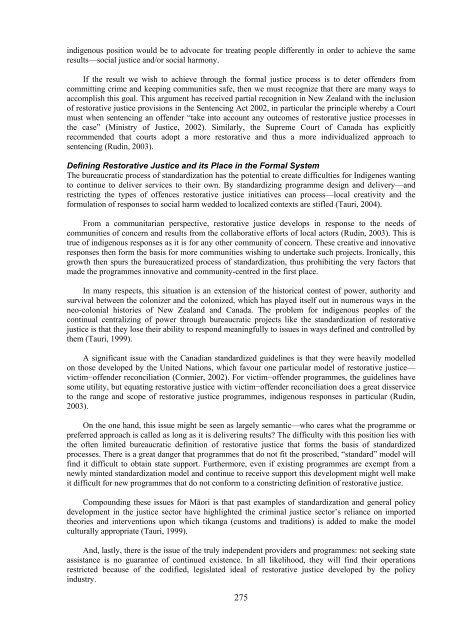traditional knowledge conference 2008 te tatau pounamu
traditional knowledge conference 2008 te tatau pounamu
traditional knowledge conference 2008 te tatau pounamu
Create successful ePaper yourself
Turn your PDF publications into a flip-book with our unique Google optimized e-Paper software.
indigenous position would be to advoca<strong>te</strong> for treating people differently in order to achieve the sameresults—social justice and/or social harmony.If the result we wish to achieve through the formal justice process is to de<strong>te</strong>r offenders fromcommitting crime and keeping communities safe, then we must recognize that there are many ways toaccomplish this goal. This argument has received partial recognition in New Zealand with the inclusionof restorative justice provisions in the Sen<strong>te</strong>ncing Act 2002, in particular the principle whereby a Courtmust when sen<strong>te</strong>ncing an offender “take into account any outcomes of restorative justice processes inthe case” (Ministry of Justice, 2002). Similarly, the Supreme Court of Canada has explicitlyrecommended that courts adopt a more restorative and thus a more individualized approach tosen<strong>te</strong>ncing (Rudin, 2003).Defining Restorative Justice and its Place in the Formal Sys<strong>te</strong>mThe bureaucratic process of standardization has the po<strong>te</strong>ntial to crea<strong>te</strong> difficulties for Indigenes wantingto continue to deliver services to their own. By standardizing programme design and delivery—andrestricting the types of offences restorative justice initiatives can process—local creativity and theformulation of responses to social harm wedded to localized con<strong>te</strong>xts are stifled (Tauri, 2004).From a communitarian perspective, restorative justice develops in response to the needs ofcommunities of concern and results from the collaborative efforts of local actors (Rudin, 2003). This istrue of indigenous responses as it is for any other community of concern. These creative and innovativeresponses then form the basis for more communities wishing to undertake such projects. Ironically, thisgrowth then spurs the bureaucratized process of standardization, thus prohibiting the very factors thatmade the programmes innovative and community-centred in the first place.In many respects, this situation is an ex<strong>te</strong>nsion of the historical con<strong>te</strong>st of power, authority andsurvival between the colonizer and the colonized, which has played itself out in numerous ways in theneo-colonial histories of New Zealand and Canada. The problem for indigenous peoples of thecontinual centralizing of power through bureaucratic projects like the standardization of restorativejustice is that they lose their ability to respond meaningfully to issues in ways defined and controlled bythem (Tauri, 1999).A significant issue with the Canadian standardized guidelines is that they were heavily modelledon those developed by the Uni<strong>te</strong>d Nations, which favour one particular model of restorative justice—victim−offender reconciliation (Cormier, 2002). For victim−offender programmes, the guidelines havesome utility, but equating restorative justice with victim−offender reconciliation does a great disserviceto the range and scope of restorative justice programmes, indigenous responses in particular (Rudin,2003).On the one hand, this issue might be seen as largely semantic—who cares what the programme orpreferred approach is called as long as it is delivering results? The difficulty with this position lies withthe of<strong>te</strong>n limi<strong>te</strong>d bureaucratic definition of restorative justice that forms the basis of standardizedprocesses. There is a great danger that programmes that do not fit the proscribed, “standard” model willfind it difficult to obtain sta<strong>te</strong> support. Furthermore, even if existing programmes are exempt from anewly min<strong>te</strong>d standardization model and continue to receive support this development might well makeit difficult for new programmes that do not conform to a constricting definition of restorative justice.Compounding these issues for Māori is that past examples of standardization and general policydevelopment in the justice sector have highligh<strong>te</strong>d the criminal justice sector’s reliance on impor<strong>te</strong>dtheories and in<strong>te</strong>rventions upon which tikanga (customs and traditions) is added to make the modelculturally appropria<strong>te</strong> (Tauri, 1999).And, lastly, there is the issue of the truly independent providers and programmes: not seeking sta<strong>te</strong>assistance is no guaran<strong>te</strong>e of continued exis<strong>te</strong>nce. In all likelihood, they will find their operationsrestric<strong>te</strong>d because of the codified, legisla<strong>te</strong>d ideal of restorative justice developed by the policyindustry.275
















